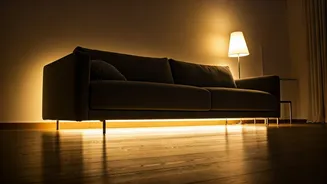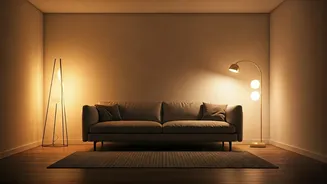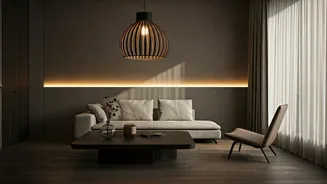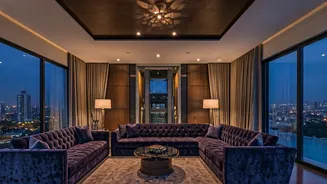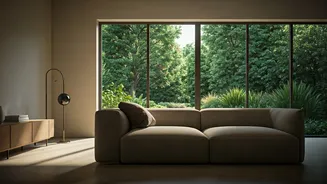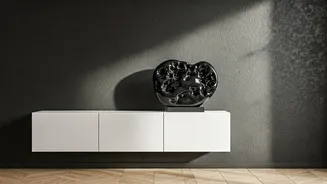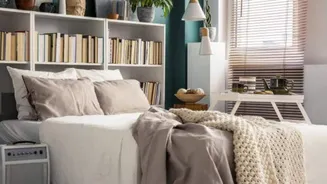Understanding Mood Lighting
Mood lighting is more than just turning on a lamp; it's about crafting an atmosphere that complements your activities and personal style. It involves using
a variety of lighting types, including ambient, task, and accent lighting, to create different effects. Ambient lighting provides general illumination, task lighting focuses on specific areas for activities like reading or cooking, and accent lighting highlights architectural features or decorative items. The key is to balance these elements to create a harmonious and inviting space. Consider the color temperature of your bulbs, with warmer tones creating a cozy feel and cooler tones providing a more energetic atmosphere. Also, factor in the intensity of the light, using dimmers to adjust the brightness based on the time of day and your desired mood. Thoughtful mood lighting can dramatically improve the comfort and functionality of your home.
Living Room Lighting
The living room is the heart of any home, and its lighting should be versatile to accommodate various activities. Begin with ambient lighting, such as a chandelier or recessed lights, to provide overall illumination. Then, introduce task lighting near seating areas with floor lamps or table lamps for reading or other activities. Accent lighting can highlight artwork or architectural features, adding depth and visual interest. Consider using a dimmer on your main lights to adjust the brightness for different occasions, from a bright setting for family gatherings to a softer glow for movie nights. Strategically placed lights can also define different zones within the living room, such as a reading nook or a conversation area. Mix and match different types of lighting, from pendants to wall sconces, to create a layered and dynamic lighting scheme. Remember that the goal is to create a welcoming and functional space that suits your lifestyle.
Bedroom Ambiance Lighting
The bedroom should be a sanctuary of relaxation, so the lighting choices should reflect this. Focus primarily on creating a soothing ambiance. Start with ambient lighting, such as a soft overhead light controlled by a dimmer. Add bedside lamps with warm-toned bulbs to provide task lighting for reading before bed. Consider incorporating accent lighting, such as a strip of LED lights behind your headboard, to create a subtle glow. Avoid overly bright or harsh lighting, as this can disrupt sleep patterns. Natural light is also important, so ensure your windows are equipped with curtains or blinds to control the amount of light that enters the room. Choose warm color temperatures for a calming effect. Think about incorporating smart lighting systems that allow you to control the lights from your bed or set automated schedules for sunrise and sunset simulation to gradually awaken you.
Kitchen Lighting Solutions
The kitchen requires a blend of functionality and style, with lighting playing a vital role in both. Efficient task lighting is essential for food preparation areas, such as countertops and the stovetop. Install under-cabinet lighting and spotlights above the stove to ensure these areas are well-lit. Ambient lighting, like recessed lights or a statement pendant over the island, provides general illumination. Accent lighting can be used to highlight decorative elements or create a more inviting atmosphere in the dining area. Make sure your lighting is energy-efficient, using LED bulbs to reduce electricity consumption. Consider using different light temperatures for different zones: warmer tones for dining areas to create a cozy feel and cooler tones for food preparation areas to enhance visibility. Ensure all lights are easy to clean and maintain, especially in areas where food is prepared.
Dining Room Illumination
The dining room should have lighting that encourages both conversation and enjoyment of meals. The most crucial element is the lighting above the dining table, such as a pendant light or chandelier. Ensure the fixture is the right size and hangs at an appropriate height above the table to avoid glare. Choose bulbs that emit warm, inviting light. Ambient lighting is necessary, provided by dimmable overhead lights or wall sconces. Accent lighting can highlight artwork or architectural details to enhance the room's aesthetic appeal. A dimmer switch is essential for adjusting the brightness to suit the occasion, from a brightly lit family dinner to a softly illuminated romantic meal. Consider layering the lighting with other sources like candles or table lamps to create additional warmth and a sense of intimacy. Avoid harsh, direct lighting, as it can detract from the dining experience.
Bathroom Lighting Ideas
Bathroom lighting must be both practical and stylish, ensuring good visibility for tasks such as grooming while also establishing a relaxing atmosphere. Key areas to focus on are the mirror and shower area. Install a light fixture above the mirror or a pair of sconces on either side to eliminate shadows and provide optimal task lighting. For the shower area, use waterproof recessed lights or a showerhead with built-in lights to create a spa-like ambiance. Ambient lighting, provided by recessed lights or a central fixture, should illuminate the entire space. Consider adding a dimmer switch to adjust the brightness and mood. Accent lighting, such as under-cabinet lights or a decorative wall sconce, can add a touch of luxury. Choose bulbs with a high CRI (Color Rendering Index) to ensure accurate color representation. Ensure all lights are moisture-resistant and safe to use in a bathroom environment.
Outdoor Lighting Designs
Extend your home's ambiance to the outdoors with thoughtful lighting. Outdoor lighting enhances safety and aesthetics. Focus on both functional and decorative lighting. Install lights along pathways and steps for safety and security. Use spotlights to highlight landscaping features such as trees, shrubs, or sculptures. Accent lights can add a decorative touch to the exterior of your home. Consider adding string lights to create a festive atmosphere on patios or decks. Choose weather-resistant fixtures and bulbs designed for outdoor use. Opt for energy-efficient LED lights to reduce electricity costs and minimize environmental impact. Use motion sensors for security lighting and consider smart lighting systems that allow you to control your outdoor lights remotely. Proper outdoor lighting can make your home safer, more inviting, and enhance your outdoor living spaces.
Choosing the Right Bulbs
Selecting the right bulbs is critical to achieving your desired lighting effects. Consider the color temperature of the bulbs, measured in Kelvin (K). Warmer temperatures (2700K to 3000K) create a cozy and inviting atmosphere, ideal for living rooms and bedrooms, while cooler temperatures (3500K to 4000K) are better for kitchens and bathrooms where bright, clear light is needed. Look at the lumens (lm), which indicate the brightness of the bulb. The higher the lumens, the brighter the light. Consider the CRI (Color Rendering Index), which measures how accurately a light source renders color. A higher CRI (80+) is recommended for areas where color accuracy is important, such as bathrooms and kitchens. LED bulbs are a great choice due to their energy efficiency and long lifespan. They come in a variety of styles and color temperatures, making them versatile for any lighting design. Consider smart bulbs, which can be controlled via a smartphone and offer features like dimming and color changing.
